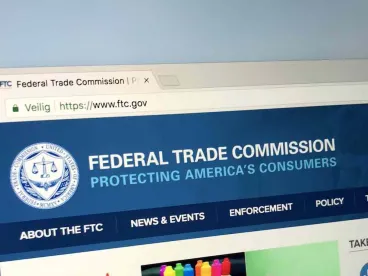A blog post from the Federal Trade Commission (“FTC”) on Tuesday was the latest announcement suggesting that a shake-up is underway for the agency’s merger review process. The post stated that the FTC’s Bureau of Competition is instituting new process reforms to make the merger review process more rigorous and streamlined. According to the post, the change was triggered by the need to best use the agency’s limited resources in light of the recent surge in merger filings. This message is consistent with other recent changes and statements from the antitrust enforcement agency suggesting that businesses should not expect “business as usual” for merger reviews.
The Hart-Scott-Rodino (“HSR”) Act requires parties engaged in certain transactions (including mergers, asset acquisitions, investments, joint ventures, and exclusive licensing deals) to file an HSR notification with the FTC and the Antitrust Division of the Department of Justice (“DOJ”), and to observe a 30-day statutorily prescribed waiting period (15 days in the case of cash tender offers and bankruptcy) prior to closing, if jurisdictional thresholds are met. The HSR process is designed to afford the agencies an opportunity to review proposed transactions for potential harm to competition. The agencies may seek additional information beyond the initial notification in a process known as a “Second Request,” which is similar to a very broad subpoena for information, data, and documents. The parties may not consummate their transaction while a Second Request investigation is pending. Responding to a Second Request is typically extremely burdensome in terms of cost (often in the millions of dollars for legal advisors, economic experts, and e-discovery vendors), time (complying can often take six months or more), disruption to the business, and delay of the transaction.
The FTC predicts that it may receive as many as 3,500 HSR notifications in 2021 — this is up from nearly 2,000 in 2020, which was double the number seen in 2010. According to the blog post, this surge in mergers is straining the regulators’ ability to challenge all anticompetitive deals. To address this challenge, the FTC is making the following changes to its merger review process:
-
The FTC may broaden the scope of Second Requests “to ensure [their] merger reviews are more comprehensive and analytically rigorous.” This might include a focus on how a proposed merger will affect labor markets, the cross-market effects of the transaction, and how the involvement of investment firms may affect market incentives to compete. Historically, these areas typically have not been part of the focus of Second Requests and merger investigations. Businesses should anticipate that the already broad scope of Second Requests will expand even further.
-
Modifications to narrow the scope of a Second Request will only be considered by FTC staff after certain “foundational information” is provided by the merging parties. It is common for merging parties to negotiate down the scope of Second Requests to reduce the burden and provide only information necessary for the agency’s antitrust review. The statement suggests that merging parties may have to overcome additional hurdles in order to receive any such modifications.
-
The FTC will align more closely with current DOJ practice in terms of how e-discovery tools may be used to assist businesses in identifying documents responsive to a Second Request.
-
Similarly, the FTC will align more closely with current DOJ practice with respect to privilege logs for productions responsive to a Second Request. In particular, the FTC is discontinuing the option to produce a “partial privilege log,” which was a log submitted only for certain (rather than all) document custodians identified by the FTC.
-
Second Requests and other information requests will be securely accessible to all FTC Commissioners. Previously, they were generally only accessible at the discretion of the Chair.
The FTC anticipates updating its model Second Request to reflect these changes.
This latest statement follows several other announcements and changes in the merger review process over the past year. For example:
-
The FTC recently voted to withdraw its approval of the Vertical Merger Guidelines (and associated commentary), issued jointly with the DOJ in 2020. According to the FTC, the guidelines included unsound economic theories, and contravened the Clayton Act with its approach to efficiencies and the pro-competitive benefits of proposed mergers.
-
In August, the FTC announced that it would begin sending “warning letters” to certain merging parties indicating that although the HSR waiting period had expired and no Second Request has been issued, an investigation into their proposed transaction remains open and closing the transaction risks a post-consummation challenge. While the antitrust enforcers have always had the ability to challenge transactions post-consummation, even after going through the HSR process, the affirmative and formal announcement of the possibility of “warning letters” suggests a significant shift in the merger review process.
-
Other recent changes to the merger review process are related to the determination of whether a particular proposed transaction is HSR reportable. Merging parties and HSR practitioners have always relied on “informal interpretations” issued by FTC staff on questions of interpretation and application of the complex and nuanced HSR rules. However, another recent blog post suggests that the issuance of and reliance on such informal interpretations may be misguided, and at times result in the non-reporting of reportable transactions.
-
The FTC reversed the long-standing interpretation that in determining whether one of the jurisdictional thresholds (the so-called “Size of Transaction”) is met, the retirement of debt need not be included in the calculation. Now, it must be included if the retirement of debt “benefits the selling shareholders.”
-
In March, the FTC and DOJ announced a “temporary” suspension of the practice of granting “early termination” of the HSR waiting period. Traditionally, early terminations, while always discretionary, had been granted to transactions that obviously had no competitive implications. The “temporary” suspension is still in effect.
This stream of changes to the merger review process signals to businesses that past experience with the merger review process is not necessarily a clear indication of what to expect for future transactions. Parties considering a merger or other acquisition transaction should engage antitrust counsel early in the process, build in sufficient time to clear the review process, and — in the case of potentially competitively sensitive transactions — expect a more burdensome and time-consuming investigation.





 />i
/>i
